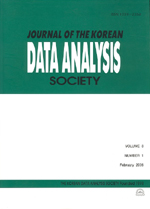GGobi를 이용한 한중일 청소년의 가치관에 관한 요인분석
Factor Analysis on Study of Values of Teenager in Korea, China and Japan Using GGobi
- 한국자료분석학회
- Journal of The Korean Data Analysis Society (JKDAS)
- Vol.15 No.2
-
2013.04769 - 783 (15 pages)
- 27

요인분석은 사회학, 심리학 관련분야에서 활발하게 사용하고 있는 다변량 통계 분석 방법이다. 그러나 요인분석 중 탐색적 요인분석은 초기 요인추출방법, 공통요인의 수, 회전 방법 등을 분석자가 주관적으로 결정하는 경향이 있으나 이들의 선택에 따라 결과가 크게 달라질 수 있다. 그러므로 최종 요인모형을 선택하기 위해 요인분석의 결과를 면밀히 살펴보아야 할 필요가 있다. 본 연구에서는 요인분석에서 최적의 요인 수, 초기 추출방법, 회전 방법 등을 선택하기 위하여 각 조건 하에서의 요인분석결과를 동적그래프 방법을 이용하여 살펴보고 이를 비교, 분석하는 방안을 제시하였다. 또한 실제 자료인 한, 중, 일 청소년 가치관에 대한 설문조사자료 중 인생에서의 중요도와 가족, 사회, 그리고 국가에 대한 신뢰도에 관한 항목들을 이용하여 요인분석을 실시하고 본 논문에서 제안한 방법을 이용하여 최적의 요인수와 초기추출방법, 그리고 회전방법을 찾고 요인분석을 실시한 후 각 나라마다의 결과를 비교, 분석하였다. 인생에서의 중요도의 경우 중국과 일본이 한국과는 다른 요인분석 결과를 나타내고 있으나 차이가 크지는 않았다. 반면 가족, 사회, 그리고 국가에 대한 신뢰도의 경우 일본이 한국과 중국의 결과와 차이를 보이고 있으며 이 차이는 다소 크게 나타나고 있다. 이 결과는 확증적 요인분석을 통하여서도 확인할 수 있었다.
Factor analysis is a widely used multi-variate data analysis method in sociology and psychology area. However the result of exploratory factor analysis depends on the initial factor extract method, number of factors, and method of rotation. It is not easy to choose the right options for the factor analysis in specific data set and we need to be careful to choose these options. In this paper, we use dynamic graphical methods to explore the result from factor analysis for the right options of the factor analysis. We explore and compare the results from the factor analysis with various options. Also we analyze the results from different population. We apply 2008 survey on the value of teenagers in three countries to our methods, find the optimal factor analysis model, and compare the result from three countries using dynamic graphical method. In the importance in life part, the result of the exploratory factor analysis on Korea is a little bit different from the results of the other two countries. On the other hands, the results of Japan in the reliability in family, society, and nation are quite different from the results of Korea and China. This result is verified from the result of the confirmatory factor analysis.
1. 서론
2. 이론적 배경
3. 연구결과
4. 결과 및 논의
References
(0)
(0)